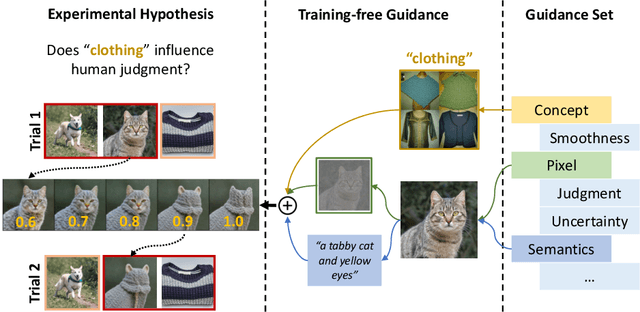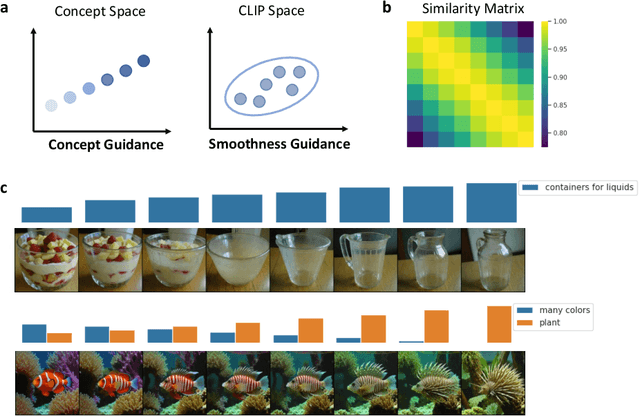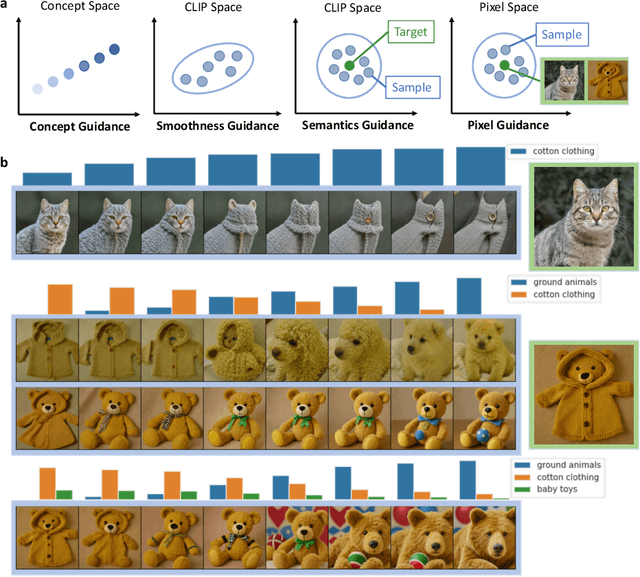Jiachen Zou
Synthesizing Images on Perceptual Boundaries of ANNs for Uncovering and Manipulating Human Perceptual Variability
May 06, 2025Abstract:Human decision-making in cognitive tasks and daily life exhibits considerable variability, shaped by factors such as task difficulty, individual preferences, and personal experiences. Understanding this variability across individuals is essential for uncovering the perceptual and decision-making mechanisms that humans rely on when faced with uncertainty and ambiguity. We present a computational framework BAM (Boundary Alignment & Manipulation framework) that combines perceptual boundary sampling in ANNs and human behavioral experiments to systematically investigate this phenomenon. Our perceptual boundary sampling algorithm generates stimuli along ANN decision boundaries that intrinsically induce significant perceptual variability. The efficacy of these stimuli is empirically validated through large-scale behavioral experiments involving 246 participants across 116,715 trials, culminating in the variMNIST dataset containing 19,943 systematically annotated images. Through personalized model alignment and adversarial generation, we establish a reliable method for simultaneously predicting and manipulating the divergent perceptual decisions of pairs of participants. This work bridges the gap between computational models and human individual difference research, providing new tools for personalized perception analysis.
CoCoG-2: Controllable generation of visual stimuli for understanding human concept representation
Jul 20, 2024



Abstract:Humans interpret complex visual stimuli using abstract concepts that facilitate decision-making tasks such as food selection and risk avoidance. Similarity judgment tasks are effective for exploring these concepts. However, methods for controllable image generation in concept space are underdeveloped. In this study, we present a novel framework called CoCoG-2, which integrates generated visual stimuli into similarity judgment tasks. CoCoG-2 utilizes a training-free guidance algorithm to enhance generation flexibility. CoCoG-2 framework is versatile for creating experimental stimuli based on human concepts, supporting various strategies for guiding visual stimuli generation, and demonstrating how these stimuli can validate various experimental hypotheses. CoCoG-2 will advance our understanding of the causal relationship between concept representations and behaviors by generating visual stimuli. The code is available at \url{https://github.com/ncclab-sustech/CoCoG-2}.
CoCoG: Controllable Visual Stimuli Generation based on Human Concept Representations
Apr 25, 2024Abstract:A central question for cognitive science is to understand how humans process visual objects, i.e, to uncover human low-dimensional concept representation space from high-dimensional visual stimuli. Generating visual stimuli with controlling concepts is the key. However, there are currently no generative models in AI to solve this problem. Here, we present the Concept based Controllable Generation (CoCoG) framework. CoCoG consists of two components, a simple yet efficient AI agent for extracting interpretable concept and predicting human decision-making in visual similarity judgment tasks, and a conditional generation model for generating visual stimuli given the concepts. We quantify the performance of CoCoG from two aspects, the human behavior prediction accuracy and the controllable generation ability. The experiments with CoCoG indicate that 1) the reliable concept embeddings in CoCoG allows to predict human behavior with 64.07\% accuracy in the THINGS-similarity dataset; 2) CoCoG can generate diverse objects through the control of concepts; 3) CoCoG can manipulate human similarity judgment behavior by intervening key concepts. CoCoG offers visual objects with controlling concepts to advance our understanding of causality in human cognition. The code of CoCoG is available at \url{https://github.com/ncclab-sustech/CoCoG}.
Visual Decoding and Reconstruction via EEG Embeddings with Guided Diffusion
Mar 14, 2024Abstract:How to decode human vision through neural signals has attracted a long-standing interest in neuroscience and machine learning. Modern contrastive learning and generative models improved the performance of fMRI-based visual decoding and reconstruction. However, the high cost and low temporal resolution of fMRI limit their applications in brain-computer interfaces (BCIs), prompting a high need for EEG-based visual reconstruction. In this study, we present an EEG-based visual reconstruction framework. It consists of a plug-and-play EEG encoder called the Adaptive Thinking Mapper (ATM), which is aligned with image embeddings, and a two-stage EEG guidance image generator that first transforms EEG features into image priors and then reconstructs the visual stimuli with a pre-trained image generator. Our approach allows EEG embeddings to achieve superior performance in image classification and retrieval tasks. Our two-stage image generation strategy vividly reconstructs images seen by humans. Furthermore, we analyzed the impact of signals from different time windows and brain regions on decoding and reconstruction. The versatility of our framework is demonstrated in the magnetoencephalogram (MEG) data modality. We report that EEG-based visual decoding achieves SOTA performance, highlighting the portability, low cost, and high temporal resolution of EEG, enabling a wide range of BCI applications. The code of ATM is available at https://github.com/dongyangli-del/EEG_Image_decode.
 Add to Chrome
Add to Chrome Add to Firefox
Add to Firefox Add to Edge
Add to Edge